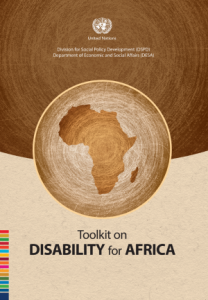- Main page: Handbook for Parliamentarians
- Joining the Convention
- Reservations to the Convention and Optional Protocol
- Declarations to the Convention and Optional Protocol
- Relevance of the Convention to non-parties
The means by which an international treaty enters into national legislation differs depending on the parliamentary system and national procedures. However, in all cases States have to take a number of steps to become parties to the Convention and Optional Protocol. These measures are standard practice under international law.
JOINING THE CONVENTION
Signing the treaty
A State becomes a party to the Convention and Optional Protocol by signing and ratifying either instrument or by acceding to them. A regional integration organization becomes a party to the Convention and Optional Protocol by signing and formally confirming its intention or by acceding to them. A precondition to signing and ratifying the Optional Protocol is having signed and ratified the Convention.
The first step in the process of becoming a party to a treaty is signing the treaty. States and regional integration organizations, such as the European Union, may sign the Convention. Any signatory State or regional integration organization that has signed the Convention may also sign the Optional Protocol. However, no prior signing is required if a country accedes to the Convention or Optional Protocol.
A State may sign the Convention and Optional Protocol at any time. Signing should be arranged with the Office of Legal Affairs at United Nations Headquarters in New York. While some treaties do not leave open the period for signing, this Convention and Optional Protocol are open for signing indefinitely.
What it means to sign the treaty
The Convention and Optional Protocol provide for a simple signing procedure. That means that there are no legal obligations imposed on a signatory State or regional integration organization immediately after the treaty is signed. However, by signing the Convention or Optional Protocol, States or regional integration organizations indicate their intention to take steps to be bound by the treaty at a later date. Signing also creates an obligation, in the period between signing and ratification or consent to be bound, to refrain from acts that would defeat the object and purpose of the treaty.
WHO MAY SIGN THE CONVENTION OR OPTIONAL PROTOCOL?
Heads of State, Heads of Government or Ministers for Foreign Affairs are empowered to sign a treaty on behalf of a State without having to produce full powers to that effect.
Other representatives intending to sign a treaty must have the appropriate full powers, issued by one of the above authorities, which expressly authorize signing the Convention or Optional Protocol by a named representative.
States or regional integration organizations wishing to sign the Convention and/or the Optional Protocol through a representative should provide copies of the required full powers in advance to the following address:
Treaty Section
Office of Legal Affairs
United Nations Headquarters
New York, New York
United States of America
Tel: +1 212 963 50 47
Fax: +1 212 963 36 93
E-mail: treaty@un.org
Expressing consent to be bound
In order to become a party to the Convention and the Optional Protocol, a State must demonstrate, through a concrete act, its willingness to undertake the legal rights and obligations contained in these two instruments. In other words, it must express its consent to be bound by the Convention and the Optional Protocol.
Under the Convention and the Optional Protocol, States may express their consent to be bound in several ways:
- Ratification (for States)
- Accession (for States and regional integration organizations)
- Formal confirmation (for regional integration organizations)
Consent to be bound by the Convention and the Optional Protocol is the act whereby States demonstrate their willingness to undertake the legal obligations under the instruments.
The ratification process
- Ratification at the international level
The Convention and the Optional Protocol both provide for States to express their consent to be bound by signature, subject to ratification. Upon ratification at the international level, the State becomes legally bound by the treaty.
- Ratification at the national level
Ratification at the international level should not be confused with ratification at the national level. At the national level, the State might have to ratify the treaty in accordance with its own constitutional or legal provisions before it expresses consent to be bound internationally. For example, the constitution might require parliament to consider the terms of the Convention and decide on ratification prior to any action at the international level that would indicate that the State consents to be bound by the treaty. However, ratification at the national level alone is not sufficient to establish a State’s intention to be legally bound at the international level. That is why ratification at the international level is still necessary, regardless of national procedures.
Ratification by regional integration organizations
The Convention and the Optional Protocol allow regional integration organizations, such as the European Union, to express their consent to be bound by either the Convention or the Optional Protocol through signing and “formal confirmation.” Formal confirmation has the same practical effect as ratification. Thus, upon formal confirmation, the regional integration organization is legally bound by the Convention and/or Optional Protocol.
Accession
A State or regional integration organization may also express its consent to be bound by the Convention or the Optional Protocol by depositing an instrument of accession with the Secretary-General of the United Nations. Accession has the same legal effect as ratification; however, unlike ratification, which must be preceded by signing to create binding legal obligations under international law, accession requires only one step, namely, depositing the instrument of accession.
THE DIFFERENCES BETWEEN SIGNING, RATIFYING,
FORMALLY CONFIRMING AND ACCEDING
Signing indicates the intention of a State to take steps to express its consent to be bound by the Convention and/or Optional Protocol at a later date. Signing also creates an obligation, in the period between signing and consent to be bound, to refrain from acts that would defeat the object and purpose of the treaty.
- Ratification legally binds a State to implement the Convention and/or Optional Protocol, subject to valid reservations, understandings and declarations.
- Formal confirmation legally binds a regional integration organization to implement the Convention and/or Optional Protocol.
- Accession legally binds a State or regional integration organization to implement the Convention and/or Optional Protocol.
The instrument of ratification, formal confirmation or accession
When a State wishes to ratify or accede to the Convention or Optional Protocol, or a regional integration organization wishes formally to confirm or accede, the State or regional integration organization must execute an instrument of ratification, formal confirmation or accession, signed by the Head of State, Head of Government or Minister for Foreign Affairs.
There is no mandated form for the instrument; however, it must include the following:
- Title, date and place of conclusion of the Convention and/or Optional Protocol;
- Full name and title of the person signing the instrument;
- An unambiguous expression of the intent of the Government, on behalf of the State, to consider itself bound by the Convention and/or Optional Protocol, and to undertake faithfully to observe and implement its provisions;
- Signature of the Head of State, Head of Government or Minister for Foreign Affairs (the official seal is not adequate) or any other person acting in such a position at the time or with full powers for that purpose issued by one of the above authorities.
The instrument of ratification, formal confirmation or accession becomes effective only when the State or regional integration organization deposits it with the Secretary-General of the United Nations at United Nations Headquarters in New York.
States or regional integration organizations should deliver such instruments to the Treaty Section of the United Nations to ensure the action is promptly processed. (See contact details for the Treaty Section above.)
When feasible, the State or regional integration organization should provide courtesy translations, in English and/or French, of instruments that are in other languages. This will help ensure that the instrument is promptly processed.
The role of parliament in the ratification process
Parliaments have a key role to play in the ratification process. While a representative of the executive – Head of State, Head of Government or the Minister for Foreign Affairs – signs and ratifies treaties, in most countries, the ultimate decision on ratification rests with parliament, which must approve ratification. This is certainly the case in countries with a civil-law tradition. However, in most countries with a common-law tradition, treaty-making power is generally vested in the executive, and parliaments have a more limited role to play in the ratification process. As international treaties increase in number and cover a growing range of subjects, with clear implications for domestic law and policy, parliaments in all countries are taking a greater interest in the executive’s prerogative to make treaties. See the checklist at the end of this section for possible actions for parliamentarians to take in this regard.
THE ROLE OF PARLIAMENT
IN THE RATIFICATION PROCESS
The role of parliaments in the ratification process varies from country to country. In Australia, Parliament reviews Government actions to ratify a treaty. Under this practice, any action relating to a treaty, such as ratification, is tabled in Parliament for a period of at least 15 sitting days before the Government takes action. When tabled in Parliament, the text of the proposed treaty is accompanied by a national interest analysis (NIA), which explains why the Government considers it appropriate to ratify. The NIA includes information relating to:
- The economic, environmental, social and cultural effects of the proposed treaty;
- The obligations imposed by the treaty;
- How the treaty will be implemented domestically;
- The financial costs associated with implementing and complying with the terms of the treaty; and
- Consultations that have been held with states, industry, community groups and other interested parties.
A Treaties Committee reviews the NIA and any other relevant material, then publishes its reviews in the national press and on its website, inviting comments from anyone with an interest in the proposed treaty action. The Committee routinely holds public hearings and presents a report to Parliament containing its advice on whether Australia should ratify or take any other action on the treaty.
In Australia, the Government can still decide to ratify a treaty even if the Treaties Committee has recommended against such action; alternatively, the Government could decide not to proceed with ratification against a Committee ratification. However, the process does provide an important means of public and parliamentary scrutiny for the Government’s decisions concerning ratification of international treaties.
When the Convention and Optional Protocol enter into force
At the moment each enters into force, the Convention and the Optional Protocol become legally binding on States parties.
It is probable that the Convention and the Optional Protocol will enter into force on two distinct dates, as the two instruments have distinct processes for entry into force:
- The Convention enters into force on the 30th day after the deposit of the 20th instrument of ratification or accession.
- The Optional Protocol enters into force on the 30th day after the deposit of the 10th instrument of ratification or accession.
Once the Convention and the Optional Protocol have entered into force at the international level, at the national and regional levels, for each ratifying State or regional integration organization, the Convention enters into force 30 days after the deposit of its instrument of ratification.
For further information on the ratification process, see the website of the Office of Legal Affairs: http://untreaty.un.org
Next – Chapter Four: Reservations to the Convention and Optional Protocol




